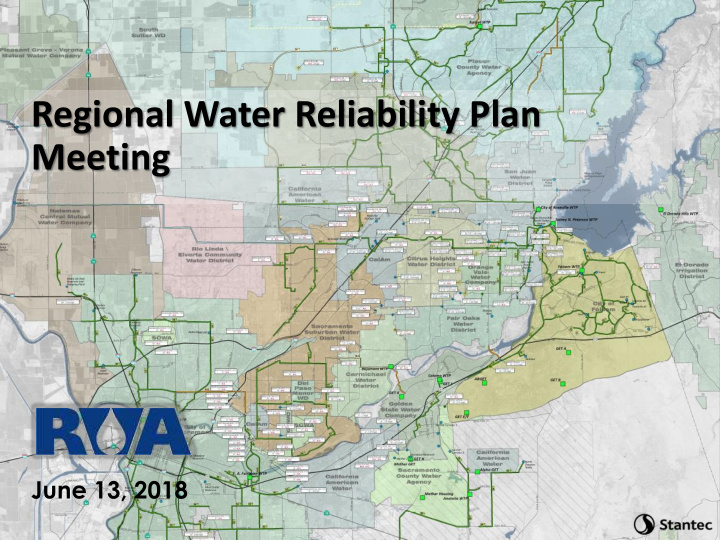



Regional Water Reliability Plan Meeting June 13, 2018
Today’s Agenda 1 Conjunctive Use Recap What is being done near- term for water marketing? 2 Water Marketing Discussion What can this be turned 3 Getting to an Operational Bank into long-term? 4 Next Steps
Conjunctive Use Recap
Conjunctive Use Recap
Simulated Groundwater Bank 10-Year Historical (Existing Potential) 10-Year Water Bank Budget Average Banked Water 25.3 (TAF/yr) Average Recovered Water 17.5 (Less Losses) (TAF/yr) Ending Banked Water 68.3 Balance (TAF) 2004 2005 2006 2007 2008 2009 2010 2011 2012 2013 Unrecoverable Water 0.9 (TAF/yr)
Simulated Groundwater Bank 10-Year Historical (Near-Term Potential ) 10-Year Water Bank Budget Average Banked Water 37.9 (TAF/yr) Average Recovered Water 27.0 (Less Losses) (TAF/yr) Ending Banked Water 94.8 TAF Balance (TAF) 2004 2005 2006 2007 2008 2009 2010 2011 2012 2013 Unrecoverable Water 1.4 (TAF/yr)
Existing vs. Near-Term Banking Operations 10-Year Water Bank Budget Existing Near-Term Increase 25.3 37.9 12.6 Average Banked Water (TAF/yr) Average Recovered Water (Less Losses) (TAF/yr) 17.5 27.0 9.5 68.3 94.8 26.5 Ending Banked Water Balance (TAF) 0.9 1.4 0.5 Unrecoverable Water (TAF/yr) $5.3 – $8.8 $8.1 – $13.5 $2.8 – $4.7 Potential Water Sale Revenue* over Simulation Period million/yr million/yr million/yr TAF = thousand acre-feet * Assumed $300 to $500 per acre-foot
Water Marketing Discussion
Institutional mechanism to allow for efficient market-based re-allocation of water supplies. Water Transfers Groundwater Banks
Voluntarily sale or/ exchange of the right to use all or a portion of the water that would have been consumptively used. Should result in “ real water ”: – Stored Surface Water – Groundwater Substitution – Crop Idling/Shifting – Conserved Water 2 types of transfers: – Short-Term (Spot Market) – Long-Term
Have regional experience with water transfers • Dating from late 90s to this year • Opportunistic, short-term spot market Key Challenges: • Unpredictable, subject to Delta conditions, administratively inefficient, customer perception
Banking is the storage of surface water in groundwater aquifer for later recovery . Involves active adaptive management (accounting, monitoring). Stored Water Sources: – Local supplies (water rights, CVP, recycled water, flood/stormwater) – External partners’ supplies (TBD) End Users: Local and/or External (agricultural, M&I, refuge, in-stream flow – augmentation) 2 potential bank types: Regional or Federally Recognized
• Streamlines transfers and exchanges • Supports expansion of conjunctive use and water marketing • Uses region’s surface water rights and entitlements • Promotes groundwater basin sustainability • Provides predictability for long-term investment
Getting to an Operational Bank
Getting to an Operational Groundwater Bank Visioning, Scoping, & Feasibility Project Implementation Foundational Determination Approvals Analyses Monitoring, Accounting, Asset Development & External Partners Initial Local Approval Reporting, & Adaptive Investment Evaluation Commitments Management External Partners Market Analysis Financial Feasibility Agreements Governance & Governance State Approvals Implementation Structure Project Description CEQA/NEPA Federal Approval
Visioning, Scoping, & Foundational Analyses Hydrological, Operational & RWRP – Conjunctive Use Physical Constraints Analysis Existing & Near-Term Asset Development & Opportunities Investment Evaluation ARBS – Conjunctive Use Infrastructure & Investment Quantify Marketable Assets Long-term Opportunities Considerations for Different Levels of Physical and Institutional Investments Legal and Environmental Constraints Analysis RWRP – Water Market Water Market Identification & Evaluation Research Market Analysis Identify Market Focus and Financial Model Development Preferences (Types, Partners, and Requirements) Financial Scenario Analysis Governance and Partnership Framework ARBS – CalSim 3.0 Governance & regional model Implementation Water Marketing Support Tools SGMA – Regional * Total cost: $0.8-$1M Develop Implementation Groundwater (IWFM) - Funded: $500k Plan to Support Targeted Model* - Unfunded: Markets and Investments South American Basin $300k Monitoring Plan Cosumnes $200k WaterSMART Water Marketing Project
Feasibility Determination External Partners Initial Partially funded by Type and level of Commitments RWRP – CVP participation in banking Engagement ($25k) Confirm local participants & Not funded their Level of participation in Financial Feasibility $50k to $200k banking. Outline preferred governance structure, and Governance Structure roles & responsibilities. Project Description Regional & Statewide Not funded Impact Analyses using CEQA/NEPA $1.18 M to $1.47 M CalSim 3.0 & Regional Groundwater Model.
Project Approvals Local Partners Each Local Approval Approve Participation in Project & Governance Confirm Participants & Their External Partners Level of Participation Agreements Not funded $120k to $235k State Water Board Notifications /Approvals (as State Approvals applicable) Reclamation Approval of Federal Approval CVPIA Groundwater Bank
Implementation Ongoing implementation activities for operating a groundwater bank. • Monitoring • Accounting • Reporting • Adaptive Management
Funding Needs for Getting to an Operational Groundwater Bank Visioning, Scoping, & Feasibility Project Approvals Implementation Foundational Analyses Determination Asset Development & Monitoring, Accounting, External Partners Initial Investment Evaluation Local Approval Reporting, & Adaptive Commitments Management Already funded Market Analysis External Partners Financial Feasibility Agreements Already funded Governance & Governance Implementation State Approvals Structure $300k - $500k (IWFM model) $50k - $200k $100k - $200k CEQA/NEPA Federal Approval $1,180k - $1,465k $20k - $35k Education & Public Engagement $150k Total Preliminary Cost for Unfunded Actions: $1.7M to $2.6M
Funding Sources & Status* Sustainable Groundwater Management Act (DWR) WaterSMART $357,000 Water Marketing 8% Project $400,000 9% Unfunded $2,200,000 American River Basin 50% Study $807,862 18% Regional Water Reliability Plan/Regional Drought Contingency Plan $658,906 15% * Excludes In-Kind Funding
Funding Proposal Discussion Fiscal Year Tasks Cost FY 18/19 $100k: State/Federal/Partners + Agency Engagement $0.5M $300k: IWFM model $100k: Public Outreach FY 19/20 $900k: CEQA/NEPA $1.1M $100k: Feasibility/Approvals $50k: Public Outreach FY 20/21 $450k: CEQA/NEPA $0.6M $150k: Approvals
Next Steps
Next Steps • RWRP Meeting – July 11 & August 8 • Initiate engagement with local & external potential partners • Develop public outreach strategy • Develop RWRP Report
Recommend
More recommend